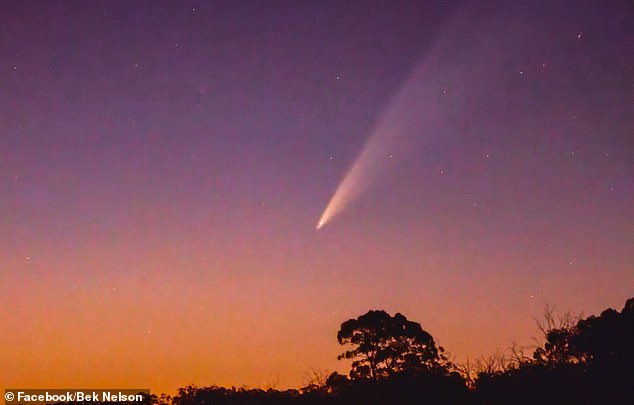- A notable celestial body is approaching to put on a display over Australia.
- The event we're discussing won't happen again for 800,000 years.
Astronomers and sky-gazers are in store for a spectacular treat, 160,000 years in the making, as a rare comet flits across the night sky in Australia this week.
A rare celestial event has just unfolded as the G3 Atlas comet has reappeared in the southern hemisphere's night sky, offering a brief, one-time spectacle that has already been captured in photographs by a few fortunate individuals in Australia.
The comet was discovered in April and Aussies wanting to observe it in greater detail should do so now because it won't be visible again for nearly eight hundred thousand years as it disappears from view on Thursday.
"Composed of dust, gas, ice, and rock.
They vary in size, spanning a few miles to tens of miles wide, but as they draw closer to the Sun, they heat up and emit large quantities of gas and dust that form a bright, glowing head, often larger than a planet.
These materials form a 'tail' that stretches millions of miles and makes them a remarkable sight in the night sky.
One of the brightest comets in recent memory is G3 Atlas, the third brightest recorded comet in history, according to the Royal Astronomical Society.
The comet has been heading towards our planet for over 100,000 years and those who wish to see it before it becomes invisible once again will need to find a spot with an unobstructed view of the western horizon.

Dr. Rebecca Allen, co-director of the Space Technology and Industry Institute at Swinburne University, stated that star-gazers can spot the G3 Atlas shortly following the sunset.
.
To increase your chances of observing it, head out just after it gets dark outside. You will require a clear view of the southwestern part of the sky, and clear conditions.
'Look for the extended line or tail pointing towards the horizon, just below the brilliant planet Venus.'
NASA astronaut Don Pettit has recently obtained an even more captivating view of the comet from space and has taken a breathtaking photograph of it passing through our solar system.
"It's truly incredible to observe a comet from an orbiting perspective," Mr. Pettit said from the International Space Station.
Photographers captured images of the comet on social media, with sightings reported from Orange, NSW, in Victoria's Mt Dandenong and Mount Barker in Adelaide Hills.
According to NASA, the G3 Atlas asteroid flew within about 8.4 million miles of the sun on January 13.
Once it moves away from Earth's orbit around the Sun, NASA estimates it won't be that close to the star again for approximately 600,000 years.
The asteroid G3 Atlas is currently positioned in the constellation of Capricorn and is approximately 146 million kilometers away from Earth, as stated by TheSkyLive.com.
"It's challenging to forecast the comet's behavior after its close encounter with the sun, which may cause it to shine more brightly or dimmer than our current predictions," Nick James from the British Astronomical Association stated.
NASA estimates there are billions of comets orbiting the Sun in the region of the solar system where Pluto resides, as well as the more distant Oort Cloud.
Read more


0 Komentar